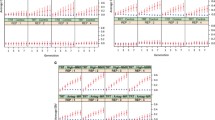Abstract
Female mice of lines divergently selected for thermoregulatory nesting were mated at 5°C and were fed eitherad libitum or restricted diets. Gestation period and litter size at birth were not affected by food restriction, but both fertility and litter size at weaning were significantly reduced by restriction. The reduction in litter size by restricted females was positively associated with the weight of both females and pups at weaning. The pattern of response to food restriction was generally more conservative than that expected on the basis of r-selection predictions. There was also a significant reduction in the proportion of males weaned by restricted females. Differences among the selected lines in both feeding regimes were generally consistent with the hypothesis that thermoregulatory nesting has a positive genetic correlation with Darwinian fitness at low temperatures.
Similar content being viewed by others
References
Barnett, S. A. (1973). Maternal processes in the cold-adaptation of mice.Biol. Rev. 48:477–508.
Barnett, S. A., Munro, K. M. H., Smart, J. L., and Stoddard, R. C. (1975). House mice bred for many generations in two environments.J. Zool. (Lond.) 177:152–169.
Berry, R. J., and Jakobson, M. E. (1971). Life and death in an island population of the house mouse.Exp. Gerontol. 6:187–197.
Bronson, F. H. (1979). The reproductive ecology of the house mouse.Q. Rev. Biol. 54:265–299.
Burley, N. (1982). Facultative sex-ratio manipulation.Am. Nat. 120:81–107.
Caswell, H. (1982). Life history theory and the equilibrium status of populations.Am. Nat. 120:317–339.
Christian, J. J. (1978). Neurobehavioral endocrine regulation of small mammal populations. In Synder, D. P. (ed.),Populations of Small Mammals under Natural Conditions, Vol. 5, Special Publication Series, Pymatuning Laboratory of Ecology, University of Pittsburgh, Pittsburgh, Pa.
Crowcroft, P., and Rowe, F. P. (1957). The growth of confined colonies of the wild house mouse (Mus musculus L.).Proc. Zool. Soc. Lond. 129:359–370.
DeLong, K. T. (1978). The effect of the manipulation of social structure on reproduction in house mice.Ecology 59:922–933.
Falconer, D. S. (1954). Selection for sex ratio in mice andDrosophila.Am. Nat. 88:385–397.
Fisher, R. A., (1958).The Genetical Theory of Natural Selection, Dover, New York.
Hairston, N. C., Tinkle, D. W., and Wilbur, H. M. (1970). Natural selection and the parameters of population growth.J. Wildl. Manage. 34:681–690.
Jensen, D. R., Beus, G. B., and Storm, G. (1968). Simultaneous statistical tests of categorical data.J. Exp. Educ. 36:46–56.
Laurie, E. M. O. (1946). The reproduction of the house mouse (Mus musculus) living in different environments.Proc. R. Soc. B 133:248–281.
Lynch, C. B. (1980). Response to divergent selection for nesting behavior inMus musculus.Genetics 96:757–765.
Lynch, C. B. (1981). Genetic correlation between two types of nesting: Direct and indirect selection.Behav. Genet. 11:267–272.
Lynch, C. B., and Possidente, B. P. (1978). Relationships of maternal nesting to thermoregulatory nesting in house mice (Mus musculus) at warm and cold temperatures.Anim. Behav. 26:1136–1143.
Lynch, C. B., Connolly, M. S., and Sulzbach, D. S. (1981). Genetic correlations among components of an adaptive syndrome.Am. Zool. 21:986.
MacArthur, R. H., and Wilson, E. O. (1967).The Theory of Island Biogeography. Princeton University Press, Princeton, N.J.
McClure, P. A. (1981). Sex-biased litter reduction in food-restricted wood rats (Neotoma floridiana).Science 211:1058–1060.
Newsome, A. E. (1969a). A population study of house mice temporarily inhabiting a South Australian wheatfield.J. Anim. Ecol. 38:341–359.
Newsome, A. E. (1969b). A population study of house mice permanently inhabiting a reedbed in South Australia.J. Anim. Ecol. 38:361–377.
Newsome, A. E., (1970). An experimental attempt to produce a mouse plague.J. Anim. Ecol. 39:299–311.
Pianka, E. R. (1970). On “r” and “K” selection.Am. Nat.,104:592–597.
Pianka, E. R. (1972).r andK selection orb andd selection?Am. Nat. 106:581–588.
Rowe, F. P., Taylor, F. J., and Chudley, A. H. S. (1964). The effect of crowding on the production of the house mouse (Mus musculus L.) living in corn ricks.J. Anim. Ecol. 33:477–483.
Schaffer, W. M. (1974). Optimal reproductive effort in fluctuating environments.Am. Nat. 108:783–790.
Snedecor, G. W., and Cochran, W. G. (1967).Statistical Methods, Iowa State, Ames.
Sokal, R. R., and Rohlf, F. J. (1981).Biometry, 2nd ed., Freeman, San Francisco.
Stearns, S. C. (1976). Life-history tactics: A review of the ideas.Q. Rev. Biol. 51:3–47.
Stearns, S. C. (1977). The evolution of life history traits.Annu. Rev. Ecol. Syst. 8:145–172.
Trivers, R. L., and Willard, D. E. (1973). Natural selection of parental ability to vary sex ratio of offspring.Science 179:90–92.
Author information
Authors and Affiliations
Additional information
This research was supported by National Institutes of Health Grant GM 21993 to C. B. L., who is the recipient of NIH Research Career Development Award ES 00042. We wish to thank Peg Batchelder and Karen Maier for their able technical assistance and G.R. Lynch, Patricia Murphy, and Peg Batchelder for comments on a draft of the manuscript.
Rights and permissions
About this article
Cite this article
Marsteller, F.A., Lynch, C.B. Reproductive consequences of food restricition at low temperature in lines of mice divergently selected for thermoregulatory nesting. Behav Genet 13, 397–410 (1983). https://doi.org/10.1007/BF01065777
Received:
Accepted:
Issue Date:
DOI: https://doi.org/10.1007/BF01065777




